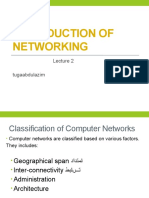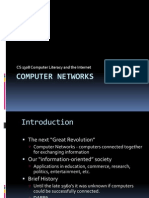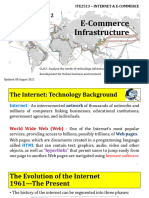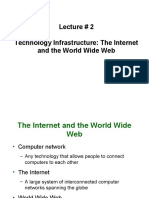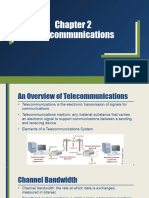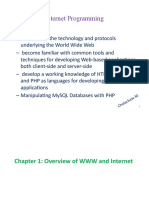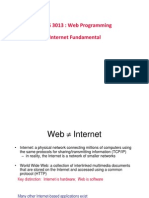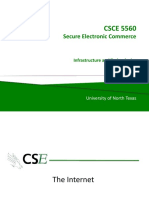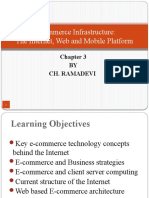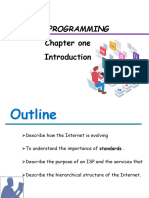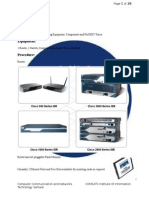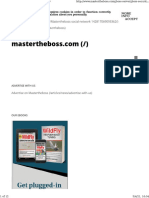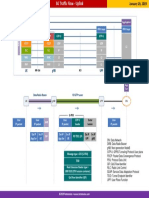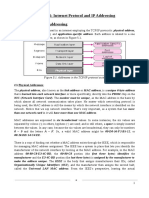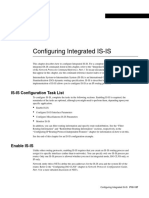CHAPTER 4
NETWORKING AND THE INTERNET
Presentation title 2
Chapter 4: Networking and the
Internet
Network
The World
Fundamental The Internet
Wide Web
s
Internet Simple Client
Security
Protocols Server
Presentation title 3
4.1 Network Fundamentals
• Network Software allows users to exchange information
and share resources
– Content
– Software
– Data storage facilities
• Network software has evolved into a network-wide
operating system
Presentation title 4
Network Classifications
Scope
• Personal Area Network (short-range)
• Local Area Network (building/campus)
• Metropolitan Area Network (community)
• Wide Area Network (greater distances)
Ownership
• Closed versus open
Topology (configuration)
• Bus (Ethernet)
• Star (Wireless networks with central Access Point)
Presentation title 5
Figure 4.1 Two popular network topologies
(1 of 2)
Presentation title 6
Protocols
• Rules by which activities are conducted on a network
– Example: Coordinating the transmission of
messages between computers
• Need to avoid all machines transmitting at the
same time
• Allows vendors to build products that are compatible
with products from other vendors
Presentation title 7
Protocols for Transmitting Messages
• CSMA/Collision Detection
– used in Ethernet
– both machines stop and wait for a independent, random
time
• CSMA/Collision Avoidance
– used in WiFi, where not all machines can hear each other
(hidden terminal problem)
– give advantage to the machine that has already been
Presentation title
waiting 8
Figure 4.2 Communication over a bus
network
Combining Networks
• Repeater: passes all messages across two busses
• Bridge: passes only messages that are destined for
computers on the other bus
• Switch: acts like a bridge, but with connections to
multiple busses
• Router: Connects two incompatible networks
resulting in a network of networks called an
internet
Presentation title 10
Methods of Process Communication
• Client-server
– Many clients, one server (executing continuously)
– Clients make requests of other processes
– Server satisfies requests made by clients
• Peer-to-peer (P2P)
– Two processes communicating as equals
– Processes execute on a temporary basis
Presentation title 11
Figure 4.6 The client/server model
compared to the peer-to-peer model
Presentation title 12
Distributed Systems
• Systems units that execute as processes on different computers
– Cluster computing
• Independent computers work closely together instead of a
single, much larger machine
– Grid computing
• Millions of home PCs (not connected to each other) work
on a complex problem
– Cloud computing
• Provide services, hide the details
Presentation title 13
4.2 The Internet
• The Internet is an internet that spans the world
– Original goal was to link a variety of networks into a
connected system unaffected by local disasters
– Today, it is a commercial undertaking that links a
worldwide combination of PANs, LANs, MANs, and
WANs involving millions of computers
Presentation title 14
Internet Architecture
• Internet Service Provider (ISP)
– Tier-1 (Internet backbone)
– Tier-2
• Access or Tier-3 ISP: Provides connectivity to the Internet
– Hot spot (wireless)
– Telephone lines
– Cellular
– Cable/Satellite systems
Presentation title 15
Internet Addressing
• IP address: pattern of 32 or 128 bits often represented in dotted
decimal notation
• Mnemonic address:
– Domain names (mu.edu)
– Top-Level Domains
• .org, .gov, .com, .mil, .net, .au, .ca, .biz, ….
• Domain name system (DNS)
– Name servers
– DNS lookup
Presentation title 16
Internet Corporation for Assigned
Names & Numbers (ICANN)
Allocates blocks of IP addresses to ISPs who then
assign those addresses within their regions.
Oversees the registration of domains and domain
names.
Presentation title 17
More Recent Applications
Voice Over IP (VoIP) Internet Multimedia
Streaming
N-unicast
Multicast
On-demand streaming
Content delivery networks (CDNs)
Presentation title 18
4.3 World Wide Web
Hypertext combines internet
Embeds hyperlinks to other
technology with concept of documents
linked-documents
Browsers present materials to the user
Webservers provide access to documents
Documents are identified by URLs and transferred using HTTP
Presentation title 19
Figure 4.8 A typical URL
Presentation title 20
Figure 4.9 A simple webpage
Presentation title 21
Extensible Markup Language (XML)
• XML: A language for constructing markup languages
similar to HTML
• A descendant of the Standard Generalized Markup
Language
• Opens door to a World Wide Semantic Web
Presentation title 22
Figure 4.11 The first two bars of
Beethoven’s Fifth Symphony
Presentation title 23
Client Side Versus Server Side
Client-side activities (browser)
• Javascript
• Java applets
• Macromedia Flash
Server-side activities (webserver)
• Common Gateway Interface (CGI)
• Servlets
• JavaServer Pages (JSP) / Active Server Pages (ASP)
• PHP
Presentation title 24
4.4 Internet Protocols
Control how messages are transferred over the
Internet
This software must reside on every computer in the
Internet
Accomplished by a multi-level hierarchy
Presentation title 25
Figure 4.12 Package-shipping example
Internet Software Layers
Application: Constructs message with address
Transport: Chops message into packets
Network: Handles routing through the Internet
Link: Handles actual transmission of packets
Presentation title 27
TCP/IP Protocol Suite
Transport Layer Network Layer
Transmission Control Protocol (TCP) Internet Protocol (IP)
User Datagram Protocol (UDP) • IPv4
• IPv6
Presentation title 28
Figure 4.15 Choosing between TCP
and UDP
Presentation title 29
4.5 Simple Client Server Program
• Socket: an abstraction for processes at the application
layer to connect to the network via the transport layer
– Needs to know
• Source Address name (localhost)
• Source Port number(1023…65535)
• Destination Address
• Destination Port number
Presentation title 30
4.6 Cybersecurity
• Forms of Attack
– Malware (viruses, worms, Trojan horses, spyware, phishing software)
– Denial of service (DoS)
– Spam (common medium for delivering malware)
• Protection and Cures
– Firewalls
– Spam filters
– Proxy Servers
– Antivirus software
Presentation title 31
Cryptography
HTTPS for secure Internet access
Public key: Used to encrypt
Public-key Encryption messages
(asymmetric) Private key: Used to decrypt
messages
Trusted to maintain lists of public
keys
Certificate Authorities Provide Certificates to clients
containing a party’s name and its
public key
Presentation title 32
Thank you
Dr AlRAWI musabalrawi@halic www.halic.edu.tr
.edu.tr
Presentation title 33

